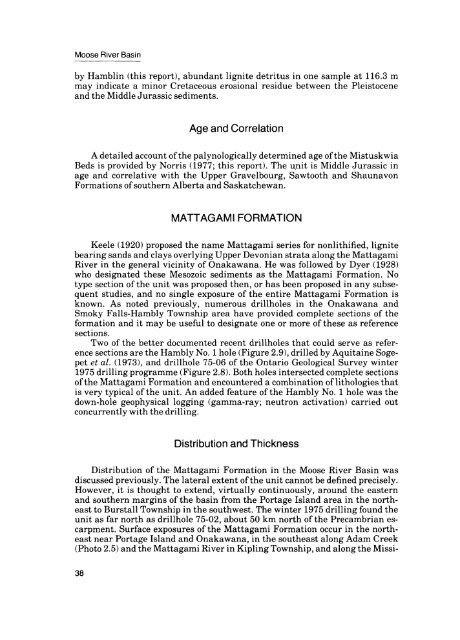Moose River Basin: geology and mineral potential - Geology Ontario
Moose River Basin: geology and mineral potential - Geology Ontario
Moose River Basin: geology and mineral potential - Geology Ontario
Create successful ePaper yourself
Turn your PDF publications into a flip-book with our unique Google optimized e-Paper software.
<strong>Moose</strong> <strong>River</strong> <strong>Basin</strong><br />
by Hamblin (this report), abundant lignite detritus in one sample at 116.3 m<br />
may indicate a minor Cretaceous erosional residue between the Pleistocene<br />
<strong>and</strong> the Middle Jurassic sediments.<br />
Age <strong>and</strong> Correlation<br />
A detailed account of the palynologically determined age of the Mistuskwia<br />
Beds is provided by Norris (1977; this report). The u,nit is Middle Jurassic in<br />
age <strong>and</strong> correlative with the Upper Gravelbourg, Sawtooth <strong>and</strong> Shaunavon<br />
Formations of southern Alberta <strong>and</strong> Saskatchewan.<br />
MATTAGAMI FORMATION<br />
Keele (1920) proposed the name Mattagami series for nonlithified, lignite<br />
bearing s<strong>and</strong>s <strong>and</strong> clays overlying Upper Devonian strata along the Mattagami<br />
<strong>River</strong> in the general vicinity of Onakawana. He was followed by Dyer (1928)<br />
who designated these Mesozoic sediments as the Mattagami Formation. No<br />
type section of the unit was proposed then, or has been proposed in any subse<br />
quent studies, <strong>and</strong> no single exposure of the entire Mattagami Formation is<br />
known. As noted previously, numerous drillholes in the Onakawana <strong>and</strong><br />
Smoky Falls-Hambly Township area have provided complete sections of the<br />
formation <strong>and</strong> it may be useful to designate one or more of these as reference<br />
sections.<br />
Two of the better documented recent drillholes that could serve as refer<br />
ence sections are the Hambly No. l hole (Figure 2.9), drilled by Aquitaine Sogepet<br />
et al. (1973), <strong>and</strong> drillhole 75-06 of the <strong>Ontario</strong> Geological Survey winter<br />
1975 drilling programme (Figure 2.8). Both holes intersected complete sections<br />
of the Mattagami Formation <strong>and</strong> encountered a combination of lithologies that<br />
is very typical of the unit. An added feature of the Hambly No. l hole was the<br />
down-hole geophysical logging (gamma-ray; neutron activation) carried out<br />
concurrently with the drilling.<br />
Distribution <strong>and</strong> Thickness<br />
Distribution of the Mattagami Formation in the <strong>Moose</strong> <strong>River</strong> <strong>Basin</strong> was<br />
discussed previously. The lateral extent of the unit cannot be defined precisely.<br />
However, it is thought to extend, virtually continuously, around the eastern<br />
<strong>and</strong> southern margins of the basin from the Portage Isl<strong>and</strong> area in the north<br />
east to Burstall Township in the southwest. The winter 1975 drilling found the<br />
unit as far north as drillhole 75-02, about 50 km north of the Precambrian es<br />
carpment. Surface exposures of the Mattagami Formation occur in the north<br />
east near Portage Isl<strong>and</strong> <strong>and</strong> Onakawana, in the southeast along Adam Creek<br />
(Photo 2.5) <strong>and</strong> the Mattagami <strong>River</strong> in Kipling Township, <strong>and</strong> along the Missi-<br />
38

















